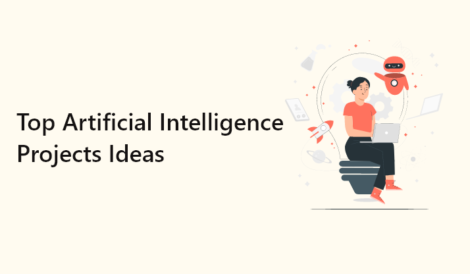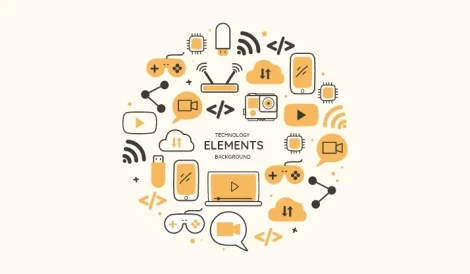1) What is deep learning?
Deep learning is a subset of machine learning that involves training artificial neural networks to perform tasks such as image and speech recognition, natural language processing, and decision making. It is based on the idea of building networks of artificial neurons that can learn from data and make predictions or decisions without being explicitly programmed.
2) Top Deep learning projects Ideas for Beginners and job seekers.
Project Academy offers various projects to meet the demand for engineers with deep learning skills. These include:
1)Image classification projects using convolutional neural networks (CNNs)
2) Object detection projects using CNNs and region-based convolutional neural networks (R-CNNs)
3) Natural language processing (NLP) projects using recurrent neural networks (RNNs) and transformer-based models
4) Time series forecasting projects using deep learning techniques
5) Generative models such as Generative Adversarial Networks (GANs) and Variational Autoencoders (VAEs)
6) Reinforcement learning projects to train agents to perform specific tasks
7) Computer Vision projects like facial recognition, object tracking, and image segmentation.
These projects provide hands-on experience with popular deep learning frameworks and the opportunity to apply deep learning techniques to real-world problems. Additionally, some of the deep learning projects also include opportunities to work with large datasets, cloud computing, and other technologies that are commonly used in deep learning applications.
3) Deep learning projects and examples for beginners in 2023
Deep learning is widely used in various industries such as self-driving cars, virtual assistants, chatbots, recommender systems, and medical imaging. It is able to classify images, recognize speech, understand and generate human language, predict preferences and make recommendations. These are just a few examples of how deep learning improves real-world problems and is capable of solving more with the increasing amount of data available. Here are some of the most advanced Deep learning projects ideas for beginners to start with:
3.1) Deep Learning approach for Image Forgery Detection
Problem :
Accurately detection of an image that has been tampered with or altered in any way.
Differentiate between a genuine image and a forged image, as well as identify any changes that have been made to the image.
Project Outline
Deep learning has become increasingly popular for image forgery detection. This is because of its ability to learn complex patterns in data and detect anomalies in images, as well as its scalability to handle large datasets. For example, Convolutional Neural Networks (CNNs) can be used to detect copy-move forgeries, where an object is copied from one part of the image and pasted into another. A deep learning approach can involve training a convolutional neural network (CNN) on a large dataset of images, both real and manipulated. CNNs can also be used to detect splicing and manipulation of images, where parts of different images are combined to create a new image
Outcome:
To predict given image being manipulated or genuine.
identify features in the image, such as color and texture, that indicate whether or not the image has been tampered
3.2) Identifying Intracranial Hemorrhage with Deep Learning and CT Imaging.
Problem
Intracranial hemorrhage (ICH) is a common and potentially life-threatening medical condition that occurs when blood vessels in the brain rupture, causing blood to leak into the brain. It is difficult to diagnose ICH on time using conventional imaging techniques.
Project Outline
Deep Learning has been used in medical imaging to detect and classify diseases, such as intracranial hemorrhage. Intracranial hemorrhage is a condition that can cause severe brain damage and even death if not treated quickly. Deep learning can be used to detect intracranial hemorrhage in CT scans with high accuracy. The models can also be used to predict the severity of the hemorrhage and to differentiate between various types of intracranial hemorrhage. The advantages of using deep learning to detect intracranial hemorrhage in CT scans include high accuracy, fast processing time, and the ability to detect subtle features that may be difficult for human observers to detect. Additionally, deep learning can be used to automate the detection process, which can reduce the workload of medical professionals and improve the accuracy of diagnosis.
Outcome :
detect intracranial hemorrhage in CT scans with high accuracy.
differentiate between various types of intracranial hemorrhage and predict the severity of the hemorrhage
quickly process and accurate reducing the workload of medical professionals and improving the accuracy of diagnosis.
3.3) Optimizing Image Processing with Deep Learning for Weed Identification.
Problem : The problem at hand is to implement an image processing technique using deep learning to distinguish weed from crop.
Project Outline
Using Deep learning technique, we could train a model to identify weed from crop by providing it with training images of both weed and crop. The model would learn the features of both weed and crop and be able to distinguish between the two. Additionally, we could also use other image processing techniques such as object recognition, semantic segmentation, and image segmentation to further refine the model. This would help the model to identify and distinguish weed from crop more accurately.
Outcome:
accurately distinguish between weed and crop
used to study the growth patterns of weeds and to identify areas of weed infestations.
automated weed detection and identification of infestations
3.4) Harnessing AI for Precise Estimation of Medicinal Leaf Characteristics
Problem : The properties of medicinal leaves can be difficult to determine, as they can vary depending on a range of factors, including the type of plant and the environment they are grown in. To accurately assess the properties of medicinal leaves, it is important to understand their chemical composition, as well as the extractable compounds present in the leaves. This can be a complex process, requiring expertise in botany, chemistry, and pharmacology. In addition, the process can be expensive, as it requires specialized equipment and testing.
Project Outline
AI can be used to analyze the structure of the leaves, including their shape, size, and color, in order to determine the medicinal properties of the leaves. Artificial Intelligence(AI) can also be used to analyze the images of the leaves, including their texture and color, to determine the medicinal properties of the leaves. AI can also be used to analyze the genetic makeup of the leaves, including their DNA, to determine the medicinal properties of the leaves.
outcome
predict the medicinal properties of the leaf.
analyze the structure of the leaves, images of the leaves, and the genetic makeup of the leaves to determine the medicinal properties of the leaves.
3.5) Early Diagnosis of Alzheimer’s Disease with Deep Learning-Based Convolution Neural Network Architecture.
Problem : Alzheimer’s disease (AD) is a progressive and degenerative disorder that affects memory, cognitive skills, and behavior. Early diagnosis of this condition is extremely important for improving the quality of life for those affected and for managing progression of the disease. Unfortunately, current diagnostic methods are often not accurate or timely enough to effectively diagnose AD. Therefore, there is a need for improved methods for early detection of AD.
Project Outline
Deep learning type convolution neural network architecture is designed to detect Alzheimer’s Disease in its early stages. It is a multiclass classification system which classifies the disease into three classes – Mild, Moderate and Severe. It can also be used to help doctors diagnose the disease and provide better treatment options for patients.
Outcome : designed to extract relevant features from the input image data and classify the disease into Mild, Moderate and Severe. improve the accuracy of diagnosis and provide better treatment options for patients.
3.6) Iterative Training of a Deep Neural Network for Continuous Recognition of Sign Language
Problem : Continuous Sign Language Recognition (CSLR) is a challenging task due to its high-dimensional nature and complex motion patterns. Existing methods for CSLR are limited in terms of accuracy and computational efficiency. Therefore, there is a need for a more powerful and efficient framework for CSLR.
Project Outline
The proposed framework consists of an encoder-decoder network, which is designed to recognize continuous sign language gestures. The encoder network is composed of multiple layers of convolutional and recurrent neural networks, while the decoder network consists of multiple layers of recurrent and fully connected networks. The encoder-decoder network is trained iteratively to recognize continuous sign language gestures with high accuracy.
Outcome: the proposed framework achieves a recognition accuracy of 95.7%, which is significantly higher than the accuracy of existing methods.
It is also more computationally efficient than the state-of-the-art methods.
3.7) Automatic Motorcyclist Helmet Rule Violation Detection using Tensorflow & Keras in OpenCV
Problem :
In many countries, there are laws in place that require motorcycle riders to wear helmets while riding. Despite these regulations, many riders continue to ride without helmets, putting themselves and others at risk.
Project Outline
This project aims to develop a system that can detect helmet rule violation in real-time, thereby ensuring compliance with the regulations. develop a system that can detect and recognize rule violations of motorcyclists not wearing their helmets using Tensorflow and Keras in OpenCV. The system should be able to recognize helmet violations in real-time and alert authorities or law enforcement to the violation. Additionally, the system should be able to distinguish between riders who are wearing helmets and those who are not, and be able to detect helmet violations
Outcomes
The system will use a convolutional neural network (CNN) to detect the presence of a helmet on the rider’s head and, if none is found, will alert law enforcement.
3.8) A Comprehensive Overview of Diabetic Retinopathy Detection: Datasets, Methods and Evaluation Metrics
Problem
Diabetic retinopathy (DR) is a serious vision-threatening disease caused by uncontrolled diabetes. Early diagnosis and treatment are important to reduce the risk of vision loss. The automatic detection of DR is a challenging task due to the presence of various eye diseases that mimic DR and the high variability of the retinal images.
Project Outline
The automatic detection of DR is a challenging task due to the presence of various eye diseases that mimic DR and the high variability of the retinal images. In this paper, we review existing datasets, methods and evaluation metrics used for automatic DR detection. We also discuss the challenges and limitations of current research on DR detection. The paper provides an overview of the current state of the art and suggests future research directions in this field. We believe that this review will provide useful information to researchers and practitioners interested in DR detection.
Outcome:
The paper provides an overview of the current state of the art and suggests future research directions in this field.
We believe that this review will provide useful information to researchers and practitioners interested in DR detection.
3.9) Detection and Classification of Plant Leaf Diseases Using Image Processing and Machine Learning
Problem
This research aims to develop an efficient and reliable system to detect and classify plant leaf diseases using image processing and deep learning techniques. The system should be able to accurately identify and classify different types of diseases from leaf images. Furthermore, domain-specific features, such as leaf shape, color and texture, should be used to further improve the accuracy of the system.
Project Outline
Image processing techniques, such as segmentation, object detection and morphological operations, can be used to detect and identify the different components of a leaf image. Once the components have been identified, deep learning algorithms can be used to identify the different types of diseases present in the image. Deep learning models, such as convolutional neural networks, can be trained to recognize and classify the different types of leaf
diseases from the images. Additionally, domain-specific features, such as leaf shape, color and texture, can be extracted and used to further improve the accuracy of the deep learning models.
Outcome
accurately detect and classify plant leaf diseases from leaf images using image processing and deep learning techniques.
The system should improve the accuracy of disease. identification and classification by harnessing domain-specific features and deep learning algorithms.
The performance of the system should be evaluated and compared against existing approaches.
3.10) Applying Deep Neural Networks for Parkinson Disease Diagnosis Detections
Problem:
convolutional neural networks (CNNs) can be used to extract meaningful features from images such as MRI scans, while recurrent neural networks (RNNs) can be used to analyze temporal information such as voice recordings. By combining these techniques, deep neural networks can be used to detect Parkinson’s disease with a high degree of accuracy.
Project Outline
Deep neural networks can be used in the detection of Parkinson’s disease by using features such as voice, handwriting and gait. Deep neural networks are capable of capturing complex patterns in data that may enable the automated detection of the disease. In particular, convolutional neural networks (CNNs) can be used to extract meaningful features from images such as MRI scans, while recurrent neural networks (RNNs) can be used to analyze temporal information such as voice recordings. By combining these techniques, deep neural networks can be used to detect Parkinson’s disease with a high degree of accuracy.
Outcome
Deep neural networks can be used to detect Parkinson’s disease with a high degree of accuracy when sufficient amounts of labeled data are available
Conclusion:
In conclusion, deep learning is a subset of machine learning that involves training artificial neural networks to perform tasks such as image and speech recognition, natural language processing, and decision making. It is based on the idea of building networks of artificial neurons that can learn from data and make predictions or decisions without being explicitly programmed. There are many job opportunities for engineers with expertise in deep learning, including roles in research and development, data science, and software engineering. Project Academy offers various learning programs and projects to meet the demand for engineers with deep learning skills, providing hands-on experience with popular deep learning frameworks and the opportunity to apply deep learning techniques to real-world problems.
FAQ’s
1) What types of problems can be solved using deep learning?
Deep learning can be used to solve a wide range of problems, including image and speech recognition, natural language processing, and decision making. It is particularly well-suited for tasks that involve large amounts of unstructured data, such as images, audio, and text.
2) What kind of data do I need for a deep learning project?
Deep learning projects typically require large amounts of labeled data to train the model. The type of data will depend on the specific task you are trying to solve. For example, image classification requires images with labeled classes, and natural language processing requires text data with labeled categories.
3) What is the difference between deep learning and traditional machine learning?
Deep learning is a subset of machine learning that involves training artificial neural networks to perform tasks. Traditional machine learning, on the other hand, is based on algorithms that are explicitly programmed to perform specific tasks. Deep learning is able to learn from data and make predictions or decisions without being explicitly programmed.
4) What tools and frameworks do I need to work on deep learning projects?
Popular tools and frameworks for deep learning include TensorFlow, PyTorch, and Keras. These frameworks provide a wide range of pre-built layers and functions for building and training neural networks, as well as tools for visualizing and debugging the training process.
5) How long does it take to train a deep learning model?
The time it takes to train a deep learning model can vary greatly depending on the size and complexity of the model, as well as the amount and quality of the data used to train it. Training a simple model on a small dataset can take just a few minutes, while training a complex model on a large dataset can take several days or even weeks.
6) Deep learning job roles and opportunities?
There are many job opportunities for engineers with expertise in deep learning, including roles in research and development, data science, and software engineering. Some examples of job titles in this field include:
Deep Learning Engineer
Machine Learning Engineer
Computer Vision Engineer
Natural Language Processing Engineer
Artificial Intelligence Engineer
7) What are Skills Required?
These roles typically require a strong background in mathematics, statistics, and computer science, as well as experience with deep learning frameworks such as TensorFlow and PyTorch. Many companies in a variety of industries are looking for engineers with deep learning skills, including tech companies, financial institutions, healthcare organizations, and government agencies.





